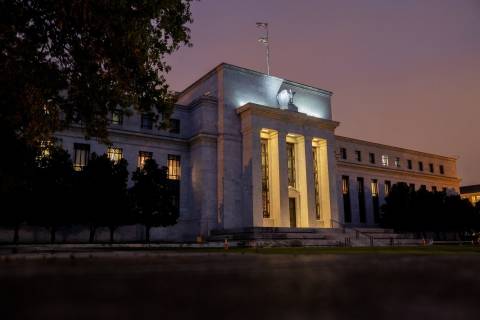
Fed Hike Bets Slump After Yield Curve Briefly Hits Four-Decade Extreme
(Bloomberg) -- Short-term Treasury yields dropped Wednesday after cooler-than-expected inflation data prompted traders to pare bets on the amount of tightening that the Federal Reserve is likely to do.
The bigger-than-expected deceleration in the growth rate of consumer prices re-established a half-point rate increase as the likeliest outcome of next month’s Fed meeting, as opposed to another three-quarter point hike. Even so, Treasury yields pared their initial declines as two central bank officials said rates hikes are likely to continue into next year.
The US two-year yield was lower by about five basis points in late trading after falling nearly 20 basis points immediately after the inflation data. Swaps referencing the Fed’s September meeting priced in 60 basis points of tightening, down from 67 basis points, which had implied a three-quarter point hike was likelier. That market also repriced the likely peak in the Fed’s policy rate lower by about five basis points to around 3.62% in the first part of 2023.
“The market perceives the Fed is still on a hiking path, but reaching a point where it may need to turn and stop,” said Jorge Portugal, managing director in rates sales and trading at Buckler Securities.
The US consumer price index increased 8.5% from a year earlier, cooling from the 9.1% June rate, which was the highest in four decades, Labor Department data showed Wednesday. A smaller deceleration was economists’ median forecast, and the price level was unexpectedly steady overall from the prior month as a drop in gasoline offset increases in food and shelter.
“The lower-than-expected pace of inflation is a welcome relief to markets, but in absolute terms, inflation remains far too high,” said Phillip Neuhart, Director of Market and Economic Research, First Citizens Bank Wealth Management. “One month does not make a trend and the Fed is likely to continue to tighten monetary policy until it is clear inflation is in a persistent downtrend.”
That point was emphasized by Minneapolis Fed President Neel Kashkari, who said the policy rate should be 4.4% by the end of next year because the Fed “is far away from declaring victory on inflation.” Earlier Wednesday, Chicago Fed President Charles Evans said he also expects the fed funds target range to be higher at the end of 2023 than at the end of this year.
Still, the paring of expectations for rate hikes left a key segment of the Treasury yield curve less inverted on the day. The two-year note’s yield ended about 44 basis points higher than the 10-year note’s, compared with close to 50 basis points higher on Tuesday. In the initial trading frenzy after the inflation data, the two-year yield briefly exceeded the 10-year by 58 basis points, the most extreme level in four decades.
Read more: US 10-Year Note Auction Stops Through; Bidding Metrics Firm
Treasury yields of all maturities initially declined after the data, but long-dated ones rebounded and ended the day higher. The 10- and 30-year sectors faced upward pressure from supply. The Treasury Department sold $35 billion of new 10-year notes Wednesday afternoon, and plans to sell $21 billion of 30-year bonds on Thursday.
(Adds comments from Fed’s Evans and Kashkari, updates yields.)
More stories like this are available on bloomberg.com
©2022 Bloomberg L.P.
Author: Liz Capo McCormick and Benjamin Purvis